Test AZ-204
Question 1:You are developing a solution that will use a multi-partitioned Azure Cosmos DB database. You plan to use the latest Azure Cosmos DB SDK for development.
The solution must meet the following requirements:
✑ Send insert and update operations to an Azure Blob storage account.
✑ Process changes to all partitions immediately.
✑ Allow parallelization of change processing.
You need to process the Azure Cosmos DB operations.
What are two possible ways to achieve this goal? Each correct answer presents a complete solution.
NOTE: Each correct selection is worth one point.
A.
Create an Azure App Service API and implement the change feed estimator of the SDK. Scale the API by using multiple Azure App Service instances.
B.
Create a background job in an Azure Kubernetes Service and implement the change feed feature of the SDK.
C.
Create an Azure Function to use a trigger for Azure Cosmos DB. Configure the trigger to connect to the container.
D.
Create an Azure Function that uses a FeedIterator object that processes the change feed by using the pull model on the container. Use a FeedRange object to parallelize the processing of the change feed across multiple functions.
Question 2:
You are building a web application that performs image analysis on user photos and returns metadata containing objects identified. The image analysis is very costly in terms of time and compute resources. You are planning to use Azure Redis Cache so duplicate uploads do not need to be reprocessed.
In case of an Azure data center outage, metadata loss must be kept to a minimum.
You need to configure the Azure Redis cache instance.
Which two actions should you perform? Each correct answer presents part of the solution.
NOTE: Each correct selection is worth one point.
A.
Configure Azure Redis with AOF persistence.
B.
Configure Azure Redis with RDB persistence.
C.
Configure second storage account for persistence.
D.
Set backup frequency to the minimum value.
Question 3:
HOTSPOT
-
You are developing an Azure Function app.
All functions in the app meet the following requirements:
• Run until either a successful run or until 10 run attempts occur.
• Ensure that there are at least 20 seconds between attempts for up to 15 minutes.
You need to configure the host.json file.
How should you complete the code segment? To answer, select the appropriate options in the answer area.
NOTE: Each correct selection is worth one point.
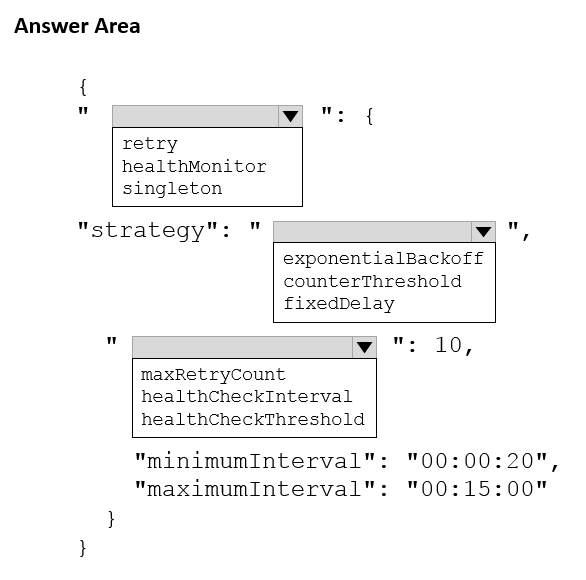
Question 4:
You need to authenticate the user to the corporate website as indicated by the architectural diagram.
Which two values should you use? Each correct answer presents part of the solution.
NOTE: Each correct selection is worth one point.
A.
ID token signature
B.
ID token claims
C.
HTTP response code
D.
Azure AD endpoint URI
E.
Azure AD tenant ID
Question 5:
HOTSPOT -
You need to retrieve the database connection string.
Which values should you use? To answer, select the appropriate options in the answer area.
NOTE: Each correct selection is worth one point.
Hot Area:
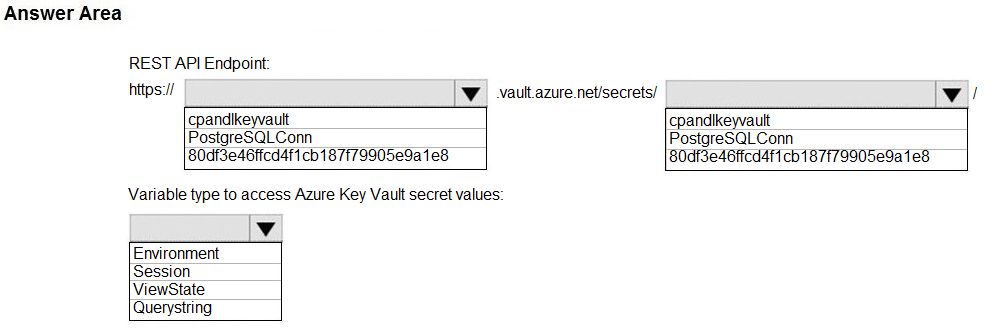
Question 6:
You need to secure the Shipping Logic App.
What should you use?
A.
Azure App Service Environment (ASE)
B.
Integration Service Environment (ISE)
C.
VNet service endpoint
D.
Azure AD B2B integration
Question 7:
HOTSPOT -
You are developing an Azure Durable Function based application that processes a list of input values. The application is monitored using a console application that retrieves JSON data from an Azure Function diagnostic endpoint.
During processing a single instance of invalid input does not cause the function to fail. Invalid input must be available to the monitoring application.
You need to implement the Azure Durable Function and the monitoring console application.
How should you complete the code segments? To answer, select the appropriate options in the answer area.
NOTE: Each correct selection is worth one point.
Hot Area:
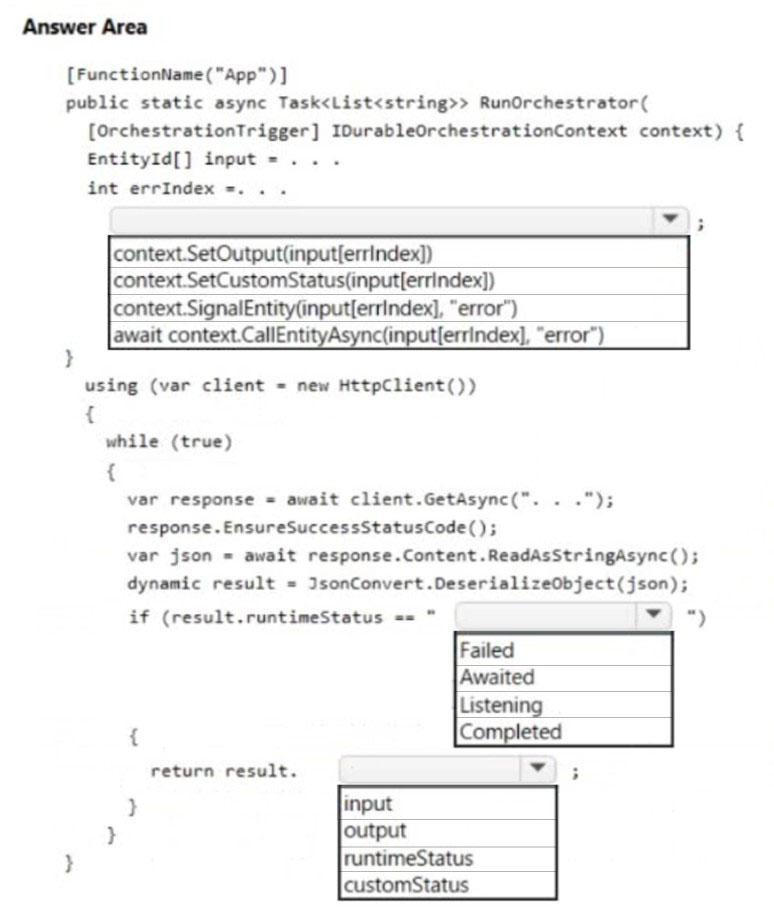
Question 8:
HOTSPOT -
You need to configure the Account Kind, Replication, and Access tier options for the corporate website's Azure Storage account.
How should you complete the configuration? To answer, select the appropriate options in the dialog box in the answer area.
NOTE: Each correct selection is worth one point.
Hot Area:
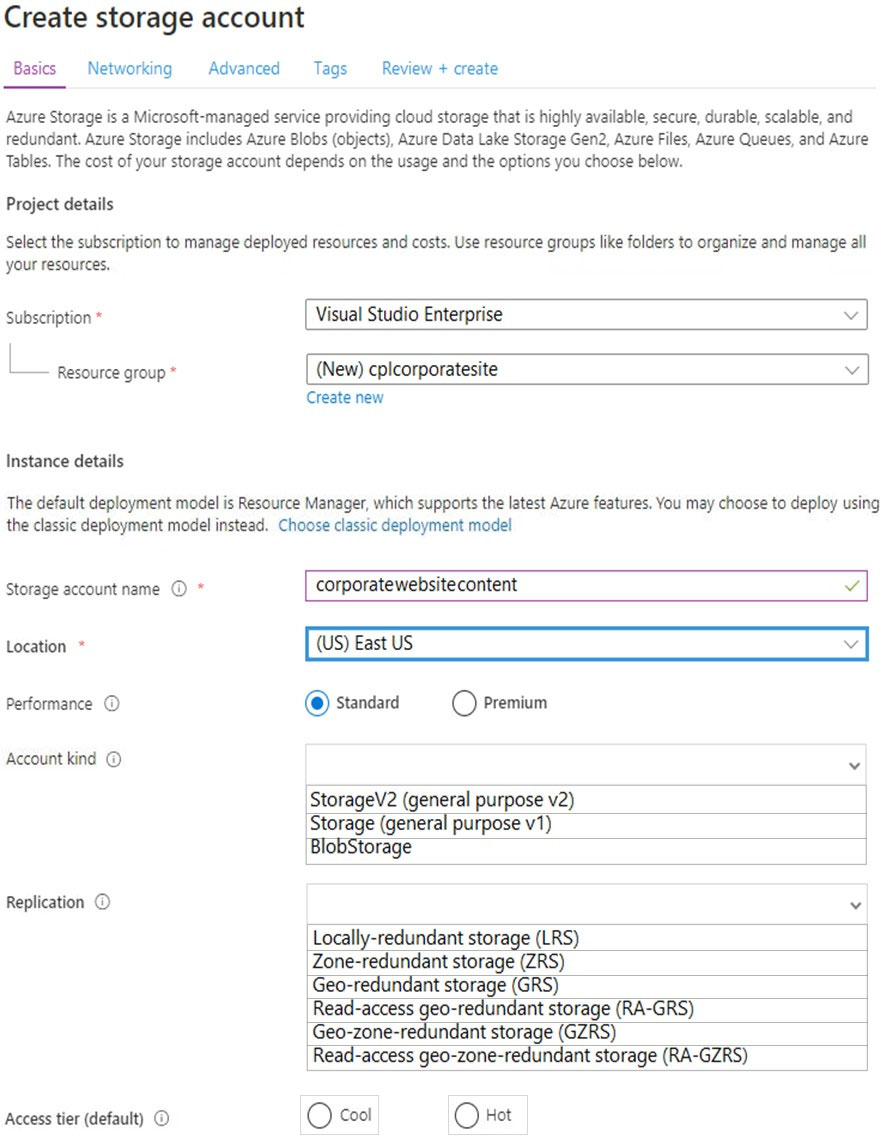
Question 9:
You are developing an inventory tracking solution. The solution includes an Azure Function app containing multiple functions triggered by Azure Cosmos DB. You plan to deploy the solution to multiple Azure regions.
The solution must meet the following requirements:
• Item results from Azure Cosmos DS must return the most recent committed version of an item.
• Items written to Azure Cosmos DB must provide ordering guarantees.
You need to configure the consistency level for the Azure Cosmos DB deployments.
Which consistency level should you use?
A.
consistent prefix
B.
eventual
C.
bounded staleness
D.
strong
E.
session
Question 10:
You develop a web application that sells access to last-minute openings for child camps that run on the weekends. The application uses Azure Application Insights for all alerting and monitoring.
The application must alert operators when a technical issue is preventing sales to camps.
You need to build an alert to detect technical issues.
Which alert type should you use?
A.
Metric alert using multiple time series
B.
Metric alert using dynamic thresholds
C.
Log alert using multiple time series
D.
Log alert using dynamic thresholds
Question 11:
HOTSPOT -
You are developing an application that uses a premium block blob storage account. The application will process a large volume of transactions daily. You enable
Blob storage versioning.
You are optimizing costs by automating Azure Blob Storage access tiers. You apply the following policy rules to the storage account. (Line numbers are included for reference only.)
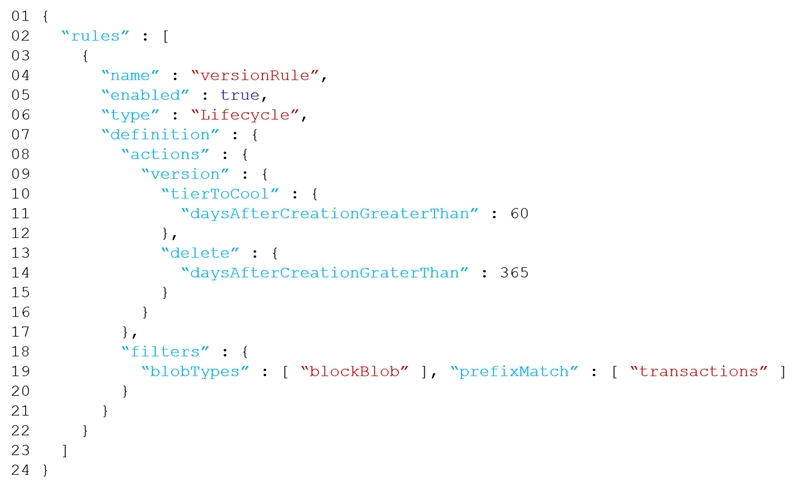
For each of the following statements, select Yes if the statement is true. Otherwise, select No.
NOTE: Each correct selection is worth one point.
Hot Area:
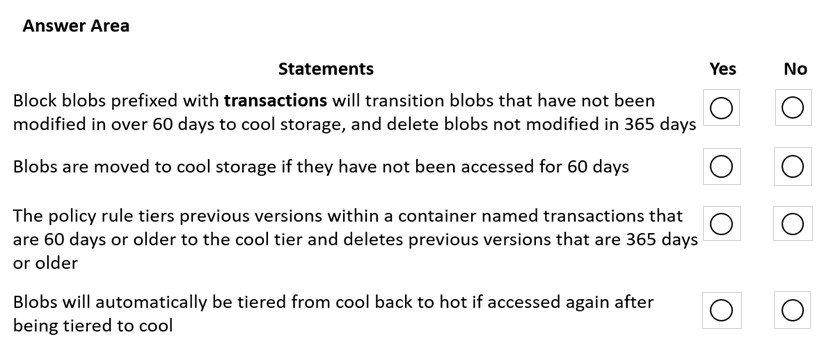
Question 12:
HOTSPOT
-
You plan to develop an Azure Functions app with an Azure Blob Storage trigger. The app will be used infrequently, with a limited duration of individual executions.
The app must meet the following requirements:
• Event-driven scaling
• Support for deployment slots
• Minimize costs
You need to identify the hosting plan and the maximum duration when executing the app.
Which configuration setting values should you use? To answer, select the appropriate values in the answer area.
NOTE: Each correct selection is worth one point.
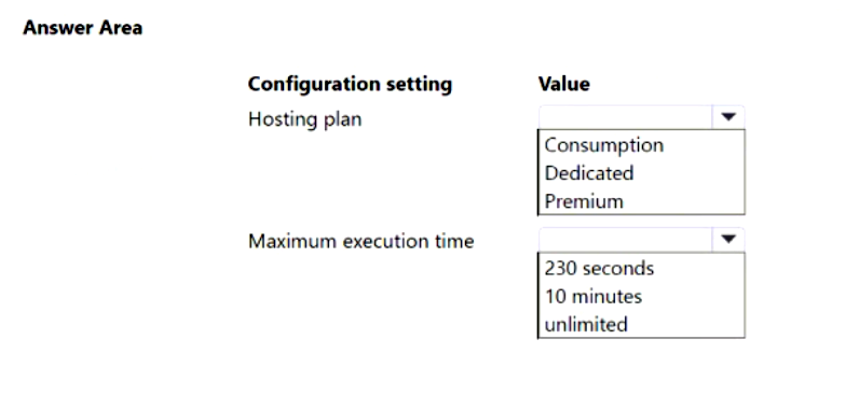
Question 13:
HOTSPOT
-
You are building a software-as-a-service (SaaS) application that analyzes DNA data that will run on Azure virtual machines (VMs) in an availability zone. The data is stored on managed disks attached to the VM. The performance of the analysis is determined by the speed of the disk attached to the VM.
You have the following requirements:
• The application must be able to quickly revert to the previous day’s data if a systemic error is detected.
• The application must minimize downtime in the case of an Azure datacenter outage.
You need to provision the managed disk for the VM to maximize performance while meeting the requirements.
Which type of Azure Managed Disk should you use? To answer, select the appropriate options in the answer area.
NOTE: Each correct selection is worth one point.
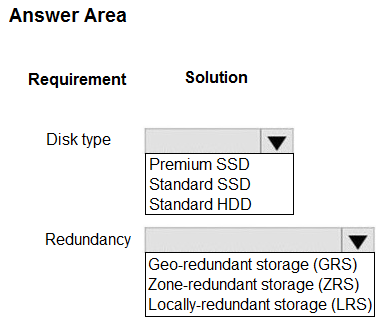
Question 14:
You are developing an application that applies a set of governance policies for internal and external services, as well as for applications.
You develop a stateful ASP.NET Core 2.1 web application named PolicyApp and deploy it to an Azure App Service Web App. The PolicyApp reacts to events from
Azure Event Grid and performs policy actions based on those events.
You have the following requirements:
✑ Authentication events must be used to monitor users when they sign in and sign out.
✑ All authentication events must be processed by PolicyApp.
✑ Sign outs must be processed as fast as possible.
What should you do?
A.
Create a new Azure Event Grid subscription for all authentication events. Use the subscription to process sign-out events.
B.
Create a separate Azure Event Grid handler for sign-in and sign-out events.
C.
Create separate Azure Event Grid topics and subscriptions for sign-in and sign-out events.
D.
Add a subject prefix to sign-out events. Create an Azure Event Grid subscription. Configure the subscription to use the subjectBeginsWith filter.
Question 15:
HOTSPOT -
You are developing an Azure Function App. You develop code by using a language that is not supported by the Azure Function App host. The code language supports HTTP primitives.
You must deploy the code to a production Azure Function App environment.
You need to configure the app for deployment.
Which configuration values should you use? To answer, select the appropriate options in the answer area.
NOTE: Each correct selection is worth one point.
Hot Area:
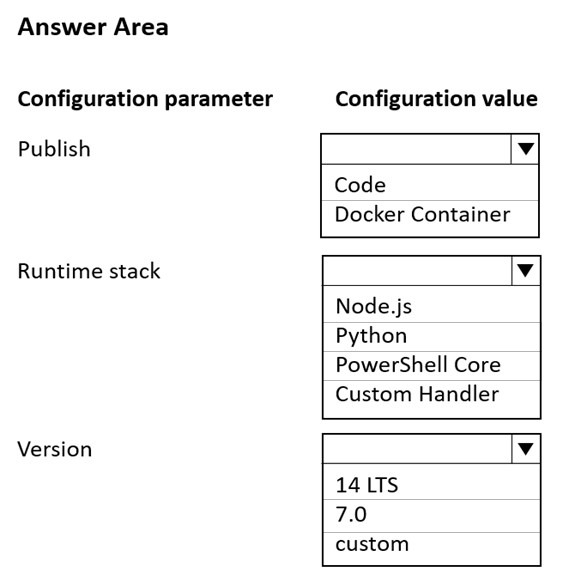
Question 16:
HOTSPOT
-
You have an App Service plan named asp1 based on the Free pricing tier.
You plan to use asp1 to implement an Azure Function app with a queue trigger. Your solution must minimize cost.
You need to identify the configuration options that will meet the requirements.
Which value should you configure? To answer, select the appropriate options in the answer area.
NOTE: Each correct selection is worth one point.
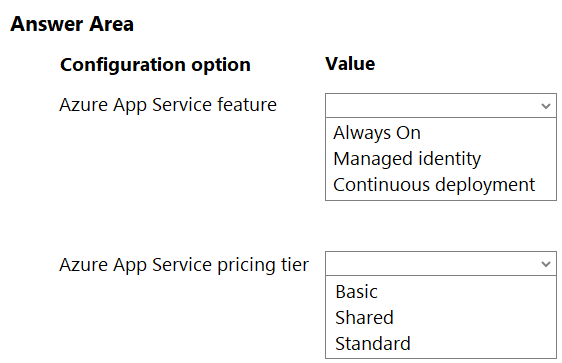
Question 17:
You are developing an application to transfer data between on-premises file servers and Azure Blob storage. The application stores keys, secrets, and certificates in Azure Key Vault and makes use of the Azure Key Vault APIs.
You want to configure the application to allow recovery of an accidental deletion of the key vault or key vault objects for 90 days after deletion.
What should you do?
A.
Run the Add-AzKeyVaultKey cmdlet.
B.
Run the az keyvault update --enable-soft-delete true --enable-purge-protection true CLI.
C.
Implement virtual network service endpoints for Azure Key Vault.
D.
Run the az keyvault update --enable-soft-delete false CLI.
Question 18:
Note: The question is included in a number of questions that depicts the identical set-up. However, every question has a distinctive result. Establish if the solution satisfies the requirements.
You are configuring a web app that delivers streaming video to users. The application makes use of continuous integration and deployment.
You need to ensure that the application is highly available and that the users' streaming experience is constant. You also want to configure the application to store data in a geographic location that is nearest to the user.
Solution: You include the use of a Storage Area Network (SAN) in your design.
Does the solution meet the goal?
A.
Yes
B.
No
Question 19:
A company is developing a solution that allows smart refrigerators to send temperature information to a central location.
The solution must receive and store messages until they can be processed. You create an Azure Service Bus instance by providing a name, pricing tier, subscription, resource group, and location.
You need to complete the configuration.
Which Azure CLI or PowerShell command should you run?
A.
B.
C.
D.
Question 20:
HOTSPOT -
You are building a traffic monitoring system that monitors traffic along six highways. The system produces time series analysis-based reports for each highway.
Data from traffic sensors are stored in Azure Event Hub.
Traffic data is consumed by four departments. Each department has an Azure Web App that displays the time series-based reports and contains a WebJob that processes the incoming data from Event Hub. All Web Apps run on App Service Plans with three instances.
Data throughput must be maximized. Latency must be minimized.
You need to implement the Azure Event Hub.
Which settings should you use? To answer, select the appropriate options in the answer area.
NOTE: Each correct selection is worth one point.
Hot Area:
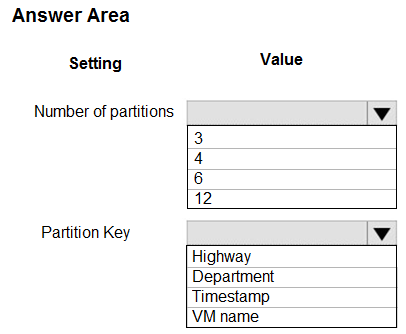
Question 21:
You are developing an Azure Function App that processes images that are uploaded to an Azure Blob container.
Images must be processed as quickly as possible after they are uploaded, and the solution must minimize latency. You create code to process images when the
Function App is triggered.
You need to configure the Function App.
What should you do?
A.
Use an App Service plan. Configure the Function App to use an Azure Blob Storage input trigger.
B.
Use a Consumption plan. Configure the Function App to use an Azure Blob Storage trigger.
C.
Use a Consumption plan. Configure the Function App to use a Timer trigger.
D.
Use an App Service plan. Configure the Function App to use an Azure Blob Storage trigger.
E.
Use a Consumption plan. Configure the Function App to use an Azure Blob Storage input trigger.
Question 22:
You are preparing to deploy a website to an Azure Web App from a GitHub repository. The website includes static content generated by a script.
You plan to use the Azure Web App continuous deployment feature.
You need to run the static generation script before the website starts serving traffic.
What are two possible ways to achieve this goal? Each correct answer presents a complete solution.
NOTE: Each correct selection is worth one point.
A.
Add the path to the static content generation tool to WEBSITE_RUN_FROM_PACKAGE setting in the host.json file.
B.
Add a PreBuild target in the websites csproj project file that runs the static content generation script.
C.
Create a file named run.cmd in the folder /run that calls a script which generates the static content and deploys the website.
D.
Create a file named .deployment in the root of the repository that calls a script which generates the static content and deploys the website.
Question 23:
Note: This question is part of a series of questions that present the same scenario. Each question in the series contains a unique solution that might meet the stated goals. Some question sets might have more than one correct solution, while others might not have a correct solution.
After you answer a question in this section, you will NOT be able to return to it. As a result, these questions will not appear in the review screen.
You develop a software as a service (SaaS) offering to manage photographs. Users upload photos to a web service which then stores the photos in Azure
Storage Blob storage. The storage account type is General-purpose V2.
When photos are uploaded, they must be processed to produce and save a mobile-friendly version of the image. The process to produce a mobile-friendly version of the image must start in less than one minute.
You need to design the process that starts the photo processing.
Solution: Move photo processing to an Azure Function triggered from the blob upload.
Does the solution meet the goal?
A.
Yes
B.
No
Question 24:
DRAG DROP -
You are developing a new page for a website that uses Azure Cosmos DB for data storage. The feature uses documents that have the following format:

You must display data for the new page in a specific order. You create the following query for the page:

You need to configure a Cosmos DB policy to support the query.
How should you configure the policy? To answer, drag the appropriate JSON segments to the correct locations. Each JSON segment may be used once, more than once, or not at all. You may need to drag the split bar between panes or scroll to view content.
NOTE: Each correct selection is worth one point.
Select and Place:
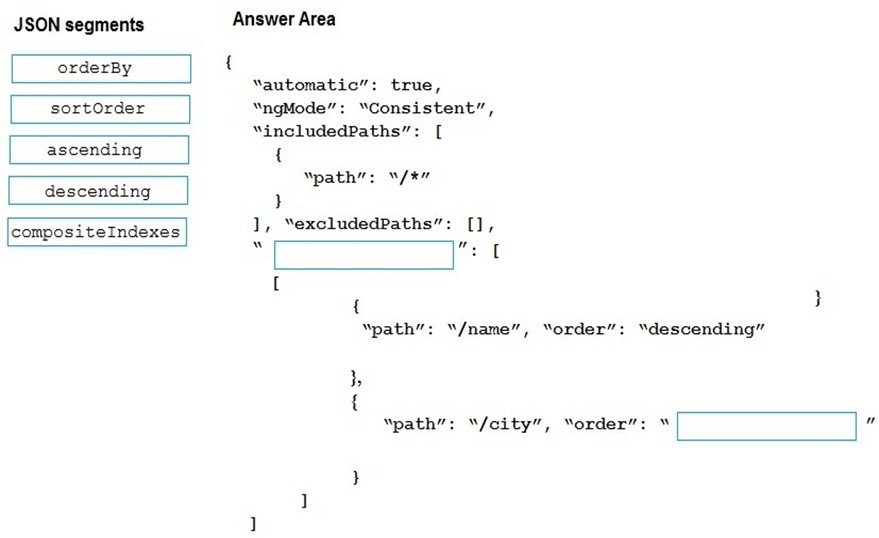
Question 25:
Note: This question is part of a series of questions that present the same scenario. Each question in the series contains a unique solution that might meet the stated goals. Some question sets might have more than one correct solution, while others might not have a correct solution.
After you answer a question in this section, you will NOT be able to return to it. As a result, these questions will not appear in the review screen.
You develop an HTTP triggered Azure Function app to process Azure Storage blob data. The app is triggered using an output binding on the blob.
The app continues to time out after four minutes. The app must process the blob data.
You need to ensure the app does not time out and processes the blob data.
Solution: Pass the HTTP trigger payload into an Azure Service Bus queue to be processed by a queue trigger function and return an immediate HTTP success response.
Does the solution meet the goal?
A.
Yes
B.
No
Question 26:
Note: The question is included in a number of questions that depicts the identical set-up. However, every question has a distinctive result. Establish if the solution satisfies the requirements.
You are developing a solution for a public facing API.
The API back end is hosted in an Azure App Service instance. You have implemented a RESTful service for the API back end.
You must configure back-end authentication for the API Management service instance.
Solution: You configure Basic gateway credentials for the HTTP(s) endpoint.
Does the solution meet the goal?
A.
Yes
B.
No
Question 27:
Note: The question is included in a number of questions that depicts the identical set-up. However, every question has a distinctive result. Establish if the solution satisfies the requirements.
You are developing a solution for a public facing API.
The API back end is hosted in an Azure App Service instance. You have implemented a RESTful service for the API back end.
You must configure back-end authentication for the API Management service instance.
Solution: You configure Client cert gateway credentials for the Azure resource.
Does the solution meet the goal?
A.
Yes
B.
No
Question 28:
HOTSPOT -
You need to add code at line AM10 of the application manifest to ensure that the requirement for manually reviewing content can be met.
How should you complete the code? To answer, select the appropriate options in the answer area.
NOTE: Each correct selection is worth one point.
Hot Area:
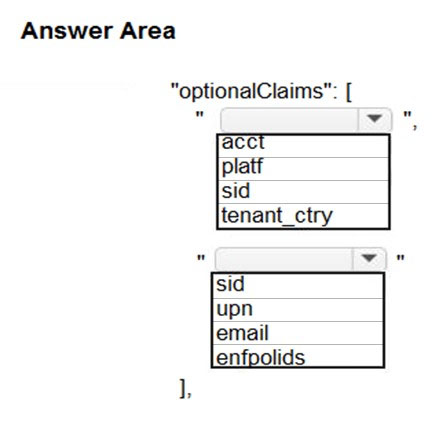
Question 29:
Note: This question is part of a series of questions that present the same scenario. Each question in the series contains a unique solution that might meet the stated goals. Some question sets might have more than one correct solution, while others might not have a correct solution.
After you answer a question in this section, you will NOT be able to return to it. As a result, these questions will not appear in the review screen.
You are implementing an application by using Azure Event Grid to push near-real-time information to customers.
You have the following requirements:
• You must send events to thousands of customers that include hundreds of various event types.
• The events must be filtered by event type before processing.
• Authentication and authorization must be handled by using Microsoft Entra ID.
• The events must be published to a single endpoint.
You need to implement Azure Event Grid.
Solution: Publish events to a custom topic. Create an event subscription for each customer.
Does the solution meet the goal?
A.
Yes
B.
No
Question 30:
HOTSPOT -
You are developing an application that uses Azure Storage Queues.
You have the following code:
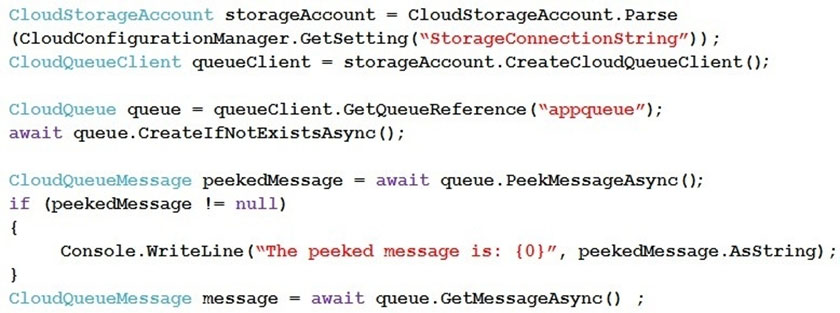
For each of the following statements, select Yes if the statement is true. Otherwise, select No.
NOTE: Each correct selection is worth one point.
Hot Area:
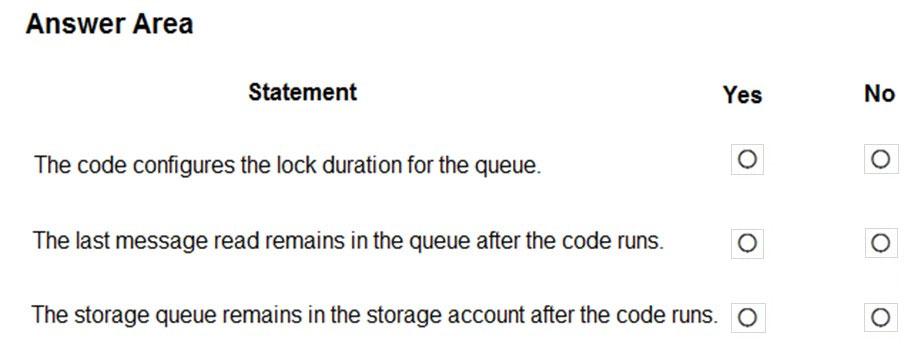
Question 31:
Note: This question is part of a series of questions that present the same scenario. Each question in the series contains a unique solution that might meet the stated goals. Some question sets might have more than one correct solution, while others might not have a correct solution.
After you answer a question in this section, you will NOT be able to return to it. As a result, these questions will not appear in the review screen.
You are developing an Azure solution to collect point-of-sale (POS) device data from 2,000 stores located throughout the world. A single device can produce 2 megabytes (MB) of data every 24 hours. Each store location has one to five devices that send data.
You must store the device data in Azure Blob storage. Device data must be correlated based on a device identifier. Additional stores are expected to open in the future.
You need to implement a solution to receive the device data.
Solution: Provision an Azure Service Bus. Configure a topic to receive the device data by using a correlation filter.
Does the solution meet the goal?
A.
Yes
B.
No
Question 32:
Note: This question is part of a series of questions that present the same scenario. Each question in the series contains a unique solution that might meet the stated goals. Some question sets might have more than one correct solution, while others might not have a correct solution.
After you answer a question in this section, you will NOT be able to return to it. As a result, these questions will not appear in the review screen.
You are developing an Azure solution to collect point-of-sale (POS) device data from 2,000 stores located throughout the world. A single device can produce 2 megabytes (MB) of data every 24 hours. Each store location has one to five devices that send data.
You must store the device data in Azure Blob storage. Device data must be correlated based on a device identifier. Additional stores are expected to open in the future.
You need to implement a solution to receive the device data.
Solution: Provision an Azure Event Grid. Configure event filtering to evaluate the device identifier.
Does the solution meet the goal?
A.
Yes
B.
No
Question 33:
HOTSPOT -
You are developing an ASP.NET Core app that includes feature flags which are managed by Azure App Configuration. You create an Azure App Configuration store named AppFeatureFlagStore that contains a feature flag named Export.
You need to update the app to meet the following requirements:
✑ Use the Export feature in the app without requiring a restart of the app.
✑ Validate users before users are allowed access to secure resources.
✑ Permit users to access secure resources.
How should you complete the code segment? To answer, select the appropriate options in the answer area.
NOTE: Each correct selection is worth one point.
Hot Area:
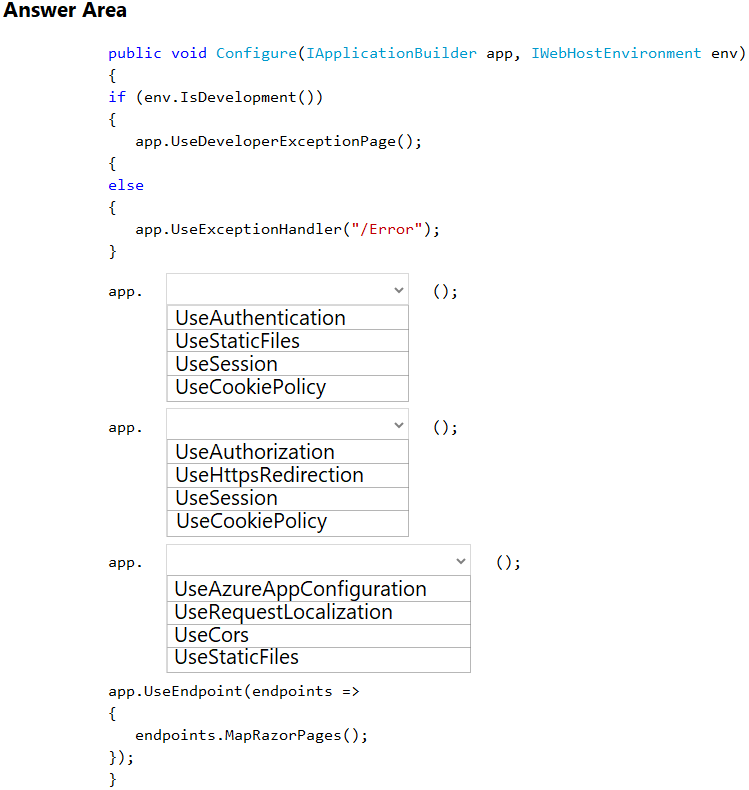
Question 34:
Note: This question is part of a series of questions that present the same scenario. Each question in the series contains a unique solution. Determine whether the solution meets the stated goals.
You are developing and deploying several ASP.NET web applications to Azure App Service. You plan to save session state information and HTML output.
You must use a storage mechanism with the following requirements:
✑ Share session state across all ASP.NET web applications.
✑ Support controlled, concurrent access to the same session state data for multiple readers and a single writer.
✑ Save full HTTP responses for concurrent requests.
You need to store the information.
Proposed Solution: Deploy and configure an Azure Database for PostgreSQL. Update the web applications.
Does the solution meet the goal?
A.
Yes
B.
No
Question 35:
You are developing an application that uses keys stored in Azure Key Vault.
You need to enforce a specific cryptographic algorithm and key size for keys stored in the vault.
What should you use?
A.
Secret versioning
B.
Azure Policy
C.
Key Vault Firewall
D.
Access policies
Question 36:
Case study -
This is a case study. Case studies are not timed separately. You can use as much exam time as you would like to complete each case. However, there may be additional case studies and sections on this exam. You must manage your time to ensure that you are able to complete all questions included on this exam in the time provided.
To answer the questions included in a case study, you will need to reference information that is provided in the case study. Case studies might contain exhibits and other resources that provide more information about the scenario that is described in the case study. Each question is independent of the other questions in this case study.
At the end of this case study, a review screen will appear. This screen allows you to review your answers and to make changes before you move to the next section of the exam. After you begin a new section, you cannot return to this section.
To start the case study -
To display the first question in this case study, click the Next button. Use the buttons in the left pane to explore the content of the case study before you answer the questions. Clicking these buttons displays information such as business requirements, existing environment, and problem statements. When you are ready to answer a question, click the Question button to return to the question.
Background -
Munson’s Pickles and Preserves Farm is an agricultural cooperative corporation based in Washington, US, with farms located across the United States. The company supports agricultural production resources by distributing seeds fertilizers, chemicals, fuel, and farm machinery to the farms.
Current Environment -
The company is migrating all applications from an on-premises datacenter to Microsoft Azure. Applications support distributors, farmers, and internal company staff.
Corporate website -
• The company hosts a public website located at http://www.munsonspicklesandpreservesfarm.com. The site supports farmers and distributors who request agricultural production resources.
Farms -
• The company created a new customer tenant in the Microsoft Entra admin center to support authentication and authorization for applications.
Distributors -
• Distributors integrate their applications with data that is accessible by using APIs hosted at http://www.munsonspicklesandpreservesfarm.com/api to receive and update resource data.
Requirements -
The application components must meet the following requirements:
Corporate website -
• The site must be migrated to Azure App Service.
• Costs must be minimized when hosting in Azure.
• Applications must automatically scale independent of the compute resources.
• All code changes must be validated by internal staff before release to production.
• File transfer speeds must improve, and webpage-load performance must increase.
• All site settings must be centrally stored, secured without using secrets, and encrypted at rest and in transit.
• A queue-based load leveling pattern must be implemented by using Azure Service Bus queues to support high volumes of website agricultural production resource requests.
Farms -
• Farmers must authenticate to applications by using Microsoft Entra ID.
Distributors -
• The company must track a custom telemetry value with each API call and monitor performance of all APIs.
• API telemetry values must be charted to evaluate variations and trends for resource data.
Internal staff -
• App and API updates must be validated before release to production.
• Staff must be able to select a link to direct them back to the production app when validating an app or API update.
• Staff profile photos and email must be displayed on the website once they authenticate to applications by using their Microsoft Entra ID.
Security -
• All web communications must be secured by using TLS/HTTPS.
• Web content must be restricted by country/region to support corporate compliance standards.
• The principle of least privilege must be applied when providing any user rights or process access rights.
• Managed identities for Azure resources must be used to authenticate services that support Microsoft Entra ID authentication.
Issues -
Corporate website -
• Farmers report HTTP 503 errors at the same time as internal staff report that CPU and memory usage are high.
• Distributors report HTTP 502 errors at the same time as internal staff report that average response times and networking traffic are high.
• Internal staff report webpage load sizes are large and take a long time to load.
• Developers receive authentication errors to Service Bus when they debug locally.
Distributors -
• Many API telemetry values are sent in a short period of time. Telemetry traffic, data costs, and storage costs must be reduced while preserving a statistically correct analysis of the data points sent by the APIs.
You need to configure all site configuration settings for the corporate website.
Which three actions should you perform? Each correct answer presents part of the solution.
NOTE: Each correct selection is worth one point.
A.
Create a managed identity.
B.
Update the role assignments for the Azure Key Vault.
C.
Create an Azure App Configuration store.
D.
Update the role assignments for the Azure App Configuration store.
E.
Create an Azure Key Vault.
Question 37:
HOTSPOT
-
You are developing an application that monitors data added to an Azure Blob storage account.
You need to process each change made to the storage account.
How should you complete the code segment? To answer, select the appropriate options in the answer area.
NOTE: Each correct selection is worth one point.
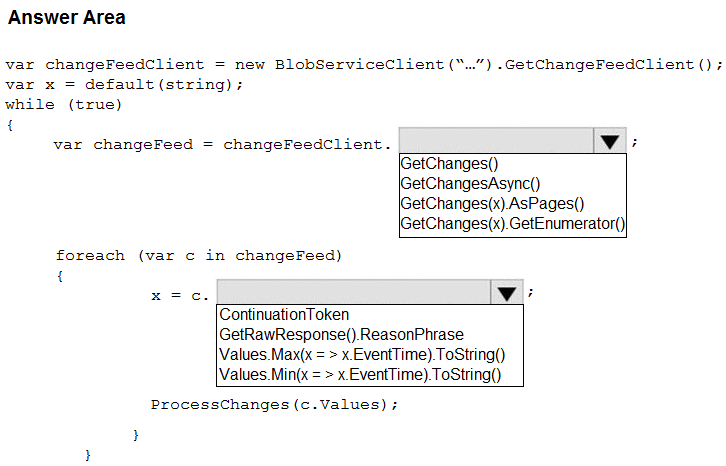
Question 38:
HOTSPOT -
You have an Azure Web app that uses Cosmos DB as a data store. You create a CosmosDB container by running the following PowerShell script:
$resourceGroupName = "testResourceGroup"
$accountName = "testCosmosAccount"
$databaseName = "testDatabase"
$containerName = "testContainer"
$partitionKeyPath = "/EmployeeId"
$autoscaleMaxThroughput = 5000
New-AzCosmosDBSqlContainer -
-ResourceGroupName $resourceGroupName
-AccountName $accountName
-DatabaseName $databaseName
-Name $containerName
-PartitionKeyKind Hash
-PartitionKeyPath $partitionKeyPath
-AutoscaleMaxThroughput $autoscaleMaxThroughput
You create the following queries that target the container:
SELECT * FROM c WHERE c.EmployeeId > '12345'
SELECT * FROM c WHERE c.UserID = '12345'
For each of the following statements, select Yes if the statement is true. Otherwise, select No.
NOTE: Each correct selection is worth one point.
Hot Area:

Question 39:
DRAG DROP
-
You are developing a web service that will run on Azure virtual machines that use Azure Storage. You configure all virtual machines to use managed identities.
You have the following requirements:
• Secret-based authentication mechanisms are not permitted for accessing an Azure Storage account.
• Must use only Azure Instance Metadata Service endpoints.
You need to write code to retrieve an access token to access Azure Storage. To answer, drag the appropriate code segments to the correct locations. Each code segment may be used once or not at all. You may need to drag the split bar between panes or scroll to view content.
NOTE: Each correct selection is worth one point.
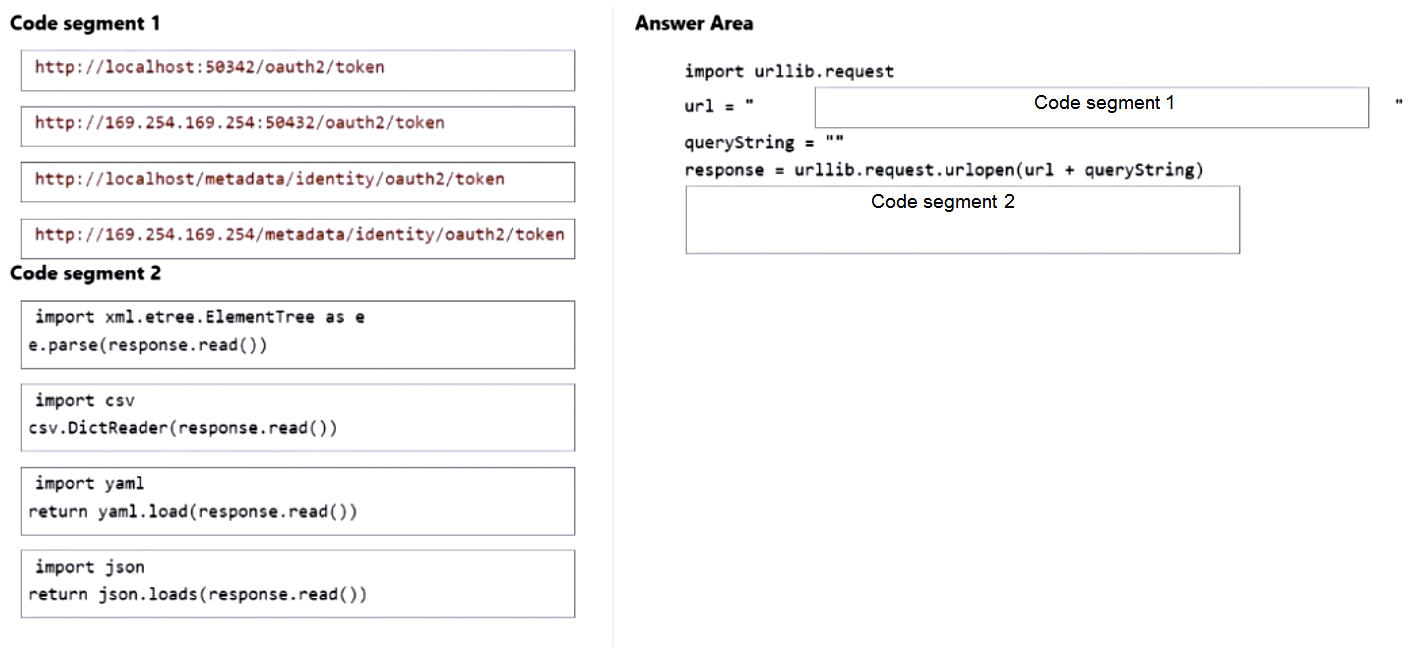
Question 40:
Note: This question is part of a series of questions that present the same scenario. Each question in the series contains a unique solution that might meet the stated goals. Some question sets might have more than one correct solution, while others might not have a correct solution.
After you answer a question in this section, you will NOT be able to return to it. As a result, these questions will not appear in the review screen.
You deploy an Azure Container Apps app and disable ingress on the container app.
Users report that they are unable to access the container app. You investigate and observe that the app has scaled to 0 instances.
You need to resolve the issue with the container app.
Solution: Enable ingress, create a custom scale rule, and apply the rule to the container app.
Does the solution meet the goal?
A.
Yes
B.
No
Question 41:
HOTSPOT
-
Case study
-
This is a case study. Case studies are not timed separately. You can use as much exam time as you would like to complete each case. However, there may be additional case studies and sections on this exam. You must manage your time to ensure that you are able to complete all questions included on this exam in the time provided.
To answer the questions included in a case study, you will need to reference information that is provided in the case study. Case studies might contain exhibits and other resources that provide more information about the scenario that is described in the case study. Each question is independent of the other questions in this case study.
At the end of this case study, a review screen will appear. This screen allows you to review your answers and to make changes before you move to the next section of the exam. After you begin a new section, you cannot return to this section.
To start the case study
-
To display the first question in this case study, click the Next button. Use the buttons in the left pane to explore the content of the case study before you answer the questions. Clicking these buttons displays information such as business requirements, existing environment, and problem statements. When you are ready to answer a question, click the Question button to return to the question.
Background
-
Munson’s Pickles and Preserves Farm is an agricultural cooperative corporation based in Washington, US, with farms located across the United States. The company supports agricultural production resources by distributing seeds fertilizers, chemicals, fuel, and farm machinery to the farms.
Current Environment
-
The company is migrating all applications from an on-premises datacenter to Microsoft Azure. Applications support distributors, farmers, and internal company staff.
Corporate website
-
• The company hosts a public website located at http://www.munsonspicklesandpreservesfarm.com. The site supports farmers and distributors who request agricultural production resources.
Farms
-
• The company created a new customer tenant in the Microsoft Entra admin center to support authentication and authorization for applications.
Distributors
-
• Distributors integrate their applications with data that is accessible by using APIs hosted at http://www.munsonspicklesandpreservesfarm.com/api to receive and update resource data.
Requirements
-
The application components must meet the following requirements:
Corporate website
-
• The site must be migrated to Azure App Service.
• Costs must be minimized when hosting in Azure.
• Applications must automatically scale independent of the compute resources.
• All code changes must be validated by internal staff before release to production.
• File transfer speeds must improve, and webpage-load performance must increase.
• All site settings must be centrally stored, secured without using secrets, and encrypted at rest and in transit.
• A queue-based load leveling pattern must be implemented by using Azure Service Bus queues to support high volumes of website agricultural production resource requests.
Farms
-
• Farmers must authenticate to applications by using Microsoft Entra ID.
Distributors
-
• The company must track a custom telemetry value with each API call and monitor performance of all APIs.
• API telemetry values must be charted to evaluate variations and trends for resource data.
Internal staff
-
• App and API updates must be validated before release to production.
• Staff must be able to select a link to direct them back to the production app when validating an app or API update.
• Staff profile photos and email must be displayed on the website once they authenticate to applications by using their Microsoft Entra ID.
Security
-
• All web communications must be secured by using TLS/HTTPS.
• Web content must be restricted by country/region to support corporate compliance standards.
• The principle of least privilege must be applied when providing any user rights or process access rights.
• Managed identities for Azure resources must be used to authenticate services that support Microsoft Entra ID authentication.
Issues
-
Corporate website
-
• Farmers report HTTP 503 errors at the same time as internal staff report that CPU and memory usage are high.
• Distributors report HTTP 502 errors at the same time as internal staff report that average response times and networking traffic are high.
• Internal staff report webpage load sizes are large and take a long time to load.
• Developers receive authentication errors to Service Bus when they debug locally.
Distributors
-
• Many API telemetry values are sent in a short period of time. Telemetry traffic, data costs, and storage costs must be reduced while preserving a statistically correct analysis of the data points sent by the APIs.
You need to correct the errors for farmers and distributors.
Which solution should you use? To answer, select the appropriate options in the answer area.
NOTE: Each correct selection is worth one point.
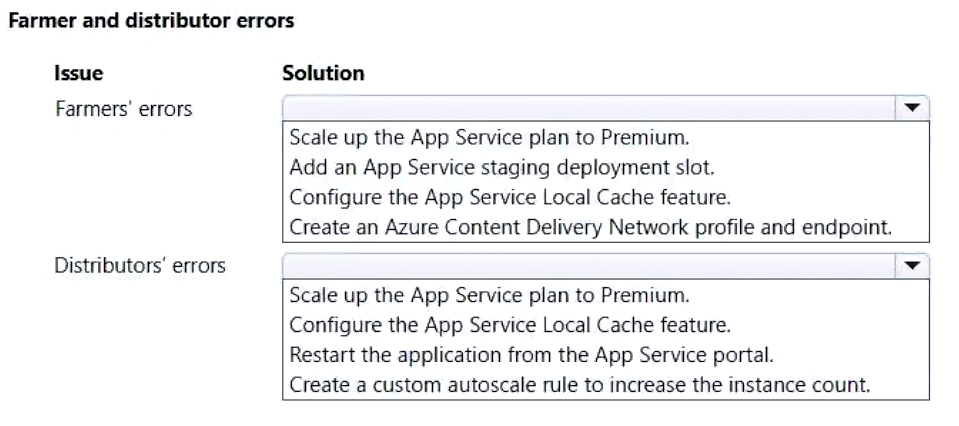
Question 42:
You are developing several microservices to run on Azure Container Apps. External HTTP ingress traffic has been enabled for the microservices.
The microservices must be deployed to the same virtual network and write logs to the same Log Analytics workspace.
You need to deploy the microservices.
What should you do?
A.
Enable single revision mode.
B.
Use a separate environment for each container.
C.
Use a private container registry image and single image for all containers.
D.
Use a single environment for all containers.
E.
Enable multiple revision mode.
Question 43:
Case study -
This is a case study. Case studies are not timed separately. You can use as much exam time as you would like to complete each case. However, there may be additional case studies and sections on this exam. You must manage your time to ensure that you are able to complete all questions included on this exam in the time provided.
To answer the questions included in a case study, you will need to reference information that is provided in the case study. Case studies might contain exhibits and other resources that provide more information about the scenario that is described in the case study. Each question is independent of the other questions in this case study.
At the end of this case study, a review screen will appear. This screen allows you to review your answers and to make changes before you move to the next section of the exam. After you begin a new section, you cannot return to this section.
To start the case study -
To display the first question in this case study, click the Next button. Use the buttons in the left pane to explore the content of the case study before you answer the questions. Clicking these buttons displays information such as business requirements, existing environment, and problem statements. When you are ready to answer a question, click the Question button to return to the question.
Background -
Munson’s Pickles and Preserves Farm is an agricultural cooperative corporation based in Washington, US, with farms located across the United States. The company supports agricultural production resources by distributing seeds fertilizers, chemicals, fuel, and farm machinery to the farms.
Current Environment -
The company is migrating all applications from an on-premises datacenter to Microsoft Azure. Applications support distributors, farmers, and internal company staff.
Corporate website -
• The company hosts a public website located at http://www.munsonspicklesandpreservesfarm.com. The site supports farmers and distributors who request agricultural production resources.
Farms -
• The company created a new customer tenant in the Microsoft Entra admin center to support authentication and authorization for applications.
Distributors -
• Distributors integrate their applications with data that is accessible by using APIs hosted at http://www.munsonspicklesandpreservesfarm.com/api to receive and update resource data.
Requirements -
The application components must meet the following requirements:
Corporate website -
• The site must be migrated to Azure App Service.
• Costs must be minimized when hosting in Azure.
• Applications must automatically scale independent of the compute resources.
• All code changes must be validated by internal staff before release to production.
• File transfer speeds must improve, and webpage-load performance must increase.
• All site settings must be centrally stored, secured without using secrets, and encrypted at rest and in transit.
• A queue-based load leveling pattern must be implemented by using Azure Service Bus queues to support high volumes of website agricultural production resource requests.
Farms -
• Farmers must authenticate to applications by using Microsoft Entra ID.
Distributors -
• The company must track a custom telemetry value with each API call and monitor performance of all APIs.
• API telemetry values must be charted to evaluate variations and trends for resource data.
Internal staff -
• App and API updates must be validated before release to production.
• Staff must be able to select a link to direct them back to the production app when validating an app or API update.
• Staff profile photos and email must be displayed on the website once they authenticate to applications by using their Microsoft Entra ID.
Security -
• All web communications must be secured by using TLS/HTTPS.
• Web content must be restricted by country/region to support corporate compliance standards.
• The principle of least privilege must be applied when providing any user rights or process access rights.
• Managed identities for Azure resources must be used to authenticate services that support Microsoft Entra ID authentication.
Issues -
Corporate website -
• Farmers report HTTP 503 errors at the same time as internal staff report that CPU and memory usage are high.
• Distributors report HTTP 502 errors at the same time as internal staff report that average response times and networking traffic are high.
• Internal staff report webpage load sizes are large and take a long time to load.
• Developers receive authentication errors to Service Bus when they debug locally.
Distributors -
• Many API telemetry values are sent in a short period of time. Telemetry traffic, data costs, and storage costs must be reduced while preserving a statistically correct analysis of the data points sent by the APIs.
You need to implement farmer authentication.
Which three actions should you perform? Each correct answer presents part of the solution.
NOTE: Each correct selection is worth one point.
A.
Add the shared access signature (SAS) token to the app.
B.
Create a shared access signature (SAS) token.
C.
Create a user flow.
D.
Add the app to the user flow.
E.
Register the app in Microsoft Entra ID.
Question 44:
Case study -
This is a case study. Case studies are not timed separately. You can use as much exam time as you would like to complete each case. However, there may be additional case studies and sections on this exam. You must manage your time to ensure that you are able to complete all questions included on this exam in the time provided.
To answer the questions included in a case study, you will need to reference information that is provided in the case study. Case studies might contain exhibits and other resources that provide more information about the scenario that is described in the case study. Each question is independent of the other questions in this case study.
At the end of this case study, a review screen will appear. This screen allows you to review your answers and to make changes before you move to the next section of the exam. After you begin a new section, you cannot return to this section.
To start the case study -
To display the first question in this case study, click the Next button. Use the buttons in the left pane to explore the content of the case study before you answer the questions. Clicking these buttons displays information such as business requirements, existing environment, and problem statements. When you are ready to answer a question, click the Question button to return to the question.
Background -
Munson’s Pickles and Preserves Farm is an agricultural cooperative corporation based in Washington, US, with farms located across the United States. The company supports agricultural production resources by distributing seeds fertilizers, chemicals, fuel, and farm machinery to the farms.
Current Environment -
The company is migrating all applications from an on-premises datacenter to Microsoft Azure. Applications support distributors, farmers, and internal company staff.
Corporate website -
• The company hosts a public website located at http://www.munsonspicklesandpreservesfarm.com. The site supports farmers and distributors who request agricultural production resources.
Farms -
• The company created a new customer tenant in the Microsoft Entra admin center to support authentication and authorization for applications.
Distributors -
• Distributors integrate their applications with data that is accessible by using APIs hosted at http://www.munsonspicklesandpreservesfarm.com/api to receive and update resource data.
Requirements -
The application components must meet the following requirements:
Corporate website -
• The site must be migrated to Azure App Service.
• Costs must be minimized when hosting in Azure.
• Applications must automatically scale independent of the compute resources.
• All code changes must be validated by internal staff before release to production.
• File transfer speeds must improve, and webpage-load performance must increase.
• All site settings must be centrally stored, secured without using secrets, and encrypted at rest and in transit.
• A queue-based load leveling pattern must be implemented by using Azure Service Bus queues to support high volumes of website agricultural production resource requests.
Farms -
• Farmers must authenticate to applications by using Microsoft Entra ID.
Distributors -
• The company must track a custom telemetry value with each API call and monitor performance of all APIs.
• API telemetry values must be charted to evaluate variations and trends for resource data.
Internal staff -
• App and API updates must be validated before release to production.
• Staff must be able to select a link to direct them back to the production app when validating an app or API update.
• Staff profile photos and email must be displayed on the website once they authenticate to applications by using their Microsoft Entra ID.
Security -
• All web communications must be secured by using TLS/HTTPS.
• Web content must be restricted by country/region to support corporate compliance standards.
• The principle of least privilege must be applied when providing any user rights or process access rights.
• Managed identities for Azure resources must be used to authenticate services that support Microsoft Entra ID authentication.
Issues -
Corporate website -
• Farmers report HTTP 503 errors at the same time as internal staff report that CPU and memory usage are high.
• Distributors report HTTP 502 errors at the same time as internal staff report that average response times and networking traffic are high.
• Internal staff report webpage load sizes are large and take a long time to load.
• Developers receive authentication errors to Service Bus when they debug locally.
Distributors -
• Many API telemetry values are sent in a short period of time. Telemetry traffic, data costs, and storage costs must be reduced while preserving a statistically correct analysis of the data points sent by the APIs.
You need to secure the corporate website to meet the security requirements.
What should you do?
A.
Create an Azure Cache for Redis instance. Update the code to support the cache.
B.
Create an Azure Content Delivery Network profile and endpoint. Configure the endpoint.С. Create an App Service instance with a standard plan. Configure the custom domain with a TLS/SSL certificate.
D.
Create an Azure Application Gateway with a Web Application Firewall (WAF). Configure end-to-end TLS encryption and the WAF.
Question 45:
HOTSPOT
-
You develop an image upload service that is exposed using Azure API Management. Images are analyzed after upload for automatic tagging.
Images over 500 KB are processed by a different backend that offers a lower tier of service that costs less money. The lower tier of service is denoted by a header named x-large-request. Images over 500 KB must never be processed by backends for smaller images and must always be charged the lower price.
You need to implement API Management policies to ensure that images are processed correctly.
How should you complete the API Management inbound policy? To answer, select the appropriate options in the answer area.
NOTE: Each correct selection is worth one point.
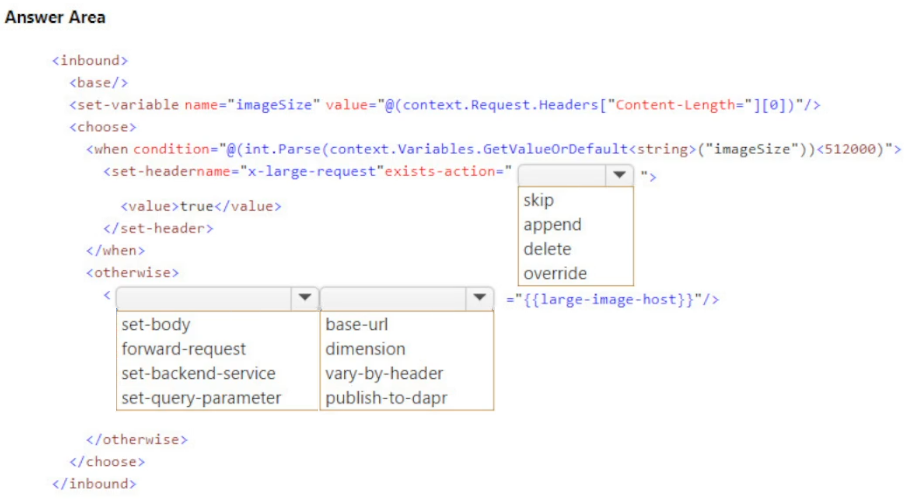
Question 46:
HOTSPOT
-
Case study
-
This is a case study. Case studies are not timed separately. You can use as much exam time as you would like to complete each case. However, there may be additional case studies and sections on this exam. You must manage your time to ensure that you are able to complete all questions included on this exam in the time provided.
To answer the questions included in a case study, you will need to reference information that is provided in the case study. Case studies might contain exhibits and other resources that provide more information about the scenario that is described in the case study. Each question is independent of the other questions in this case study.
At the end of this case study, a review screen will appear. This screen allows you to review your answers and to make changes before you move to the next section of the exam. After you begin a new section, you cannot return to this section.
To start the case study
-
To display the first question in this case study, click the Next button. Use the buttons in the left pane to explore the content of the case study before you answer the questions. Clicking these buttons displays information such as business requirements, existing environment, and problem statements. When you are ready to answer a question, click the Question button to return to the question.
Background
-
Munson’s Pickles and Preserves Farm is an agricultural cooperative corporation based in Washington, US, with farms located across the United States. The company supports agricultural production resources by distributing seeds fertilizers, chemicals, fuel, and farm machinery to the farms.
Current Environment
-
The company is migrating all applications from an on-premises datacenter to Microsoft Azure. Applications support distributors, farmers, and internal company staff.
Corporate website
-
• The company hosts a public website located at http://www.munsonspicklesandpreservesfarm.com. The site supports farmers and distributors who request agricultural production resources.
Farms
-
• The company created a new customer tenant in the Microsoft Entra admin center to support authentication and authorization for applications.
Distributors
-
• Distributors integrate their applications with data that is accessible by using APIs hosted at http://www.munsonspicklesandpreservesfarm.com/api to receive and update resource data.
Requirements
-
The application components must meet the following requirements:
Corporate website
-
• The site must be migrated to Azure App Service.
• Costs must be minimized when hosting in Azure.
• Applications must automatically scale independent of the compute resources.
• All code changes must be validated by internal staff before release to production.
• File transfer speeds must improve, and webpage-load performance must increase.
• All site settings must be centrally stored, secured without using secrets, and encrypted at rest and in transit.
• A queue-based load leveling pattern must be implemented by using Azure Service Bus queues to support high volumes of website agricultural production resource requests.
Farms
-
• Farmers must authenticate to applications by using Microsoft Entra ID.
Distributors
-
• The company must track a custom telemetry value with each API call and monitor performance of all APIs.
• API telemetry values must be charted to evaluate variations and trends for resource data.
Internal staff
-
• App and API updates must be validated before release to production.
• Staff must be able to select a link to direct them back to the production app when validating an app or API update.
• Staff profile photos and email must be displayed on the website once they authenticate to applications by using their Microsoft Entra ID.
Security
-
• All web communications must be secured by using TLS/HTTPS.
• Web content must be restricted by country/region to support corporate compliance standards.
• The principle of least privilege must be applied when providing any user rights or process access rights.
• Managed identities for Azure resources must be used to authenticate services that support Microsoft Entra ID authentication.
Issues
-
Corporate website
-
• Farmers report HTTP 503 errors at the same time as internal staff report that CPU and memory usage are high.
• Distributors report HTTP 502 errors at the same time as internal staff report that average response times and networking traffic are high.
• Internal staff report webpage load sizes are large and take a long time to load.
• Developers receive authentication errors to Service Bus when they debug locally.
Distributors
-
• Many API telemetry values are sent in a short period of time. Telemetry traffic, data costs, and storage costs must be reduced while preserving a statistically correct analysis of the data points sent by the APIs.
You need to display the profile photo and email for signed-in internal staff on the website.
Which Microsoft Graph configuration should you use? To answer, select the appropriate options in the answer area.
NOTE: Each correct selection is worth one point.
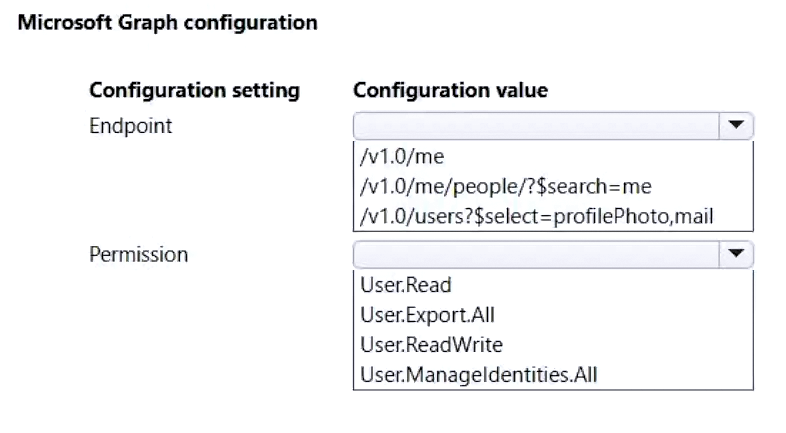
Question 47:
HOTSPOT
-
Case study
-
This is a case study. Case studies are not timed separately. You can use as much exam time as you would like to complete each case. However, there may be additional case studies and sections on this exam. You must manage your time to ensure that you are able to complete all questions included on this exam in the time provided.
To answer the questions included in a case study, you will need to reference information that is provided in the case study. Case studies might contain exhibits and other resources that provide more information about the scenario that is described in the case study. Each question is independent of the other questions in this case study.
At the end of this case study, a review screen will appear. This screen allows you to review your answers and to make changes before you move to the next section of the exam. After you begin a new section, you cannot return to this section.
To start the case study
-
To display the first question in this case study, click the Next button. Use the buttons in the left pane to explore the content of the case study before you answer the questions. Clicking these buttons displays information such as business requirements, existing environment, and problem statements. When you are ready to answer a question, click the Question button to return to the question.
Background
-
Munson’s Pickles and Preserves Farm is an agricultural cooperative corporation based in Washington, US, with farms located across the United States. The company supports agricultural production resources by distributing seeds fertilizers, chemicals, fuel, and farm machinery to the farms.
Current Environment
-
The company is migrating all applications from an on-premises datacenter to Microsoft Azure. Applications support distributors, farmers, and internal company staff.
Corporate website
-
• The company hosts a public website located at http://www.munsonspicklesandpreservesfarm.com. The site supports farmers and distributors who request agricultural production resources.
Farms
-
• The company created a new customer tenant in the Microsoft Entra admin center to support authentication and authorization for applications.
Distributors
-
• Distributors integrate their applications with data that is accessible by using APIs hosted at http://www.munsonspicklesandpreservesfarm.com/api to receive and update resource data.
Requirements
-
The application components must meet the following requirements:
Corporate website
-
• The site must be migrated to Azure App Service.
• Costs must be minimized when hosting in Azure.
• Applications must automatically scale independent of the compute resources.
• All code changes must be validated by internal staff before release to production.
• File transfer speeds must improve, and webpage-load performance must increase.
• All site settings must be centrally stored, secured without using secrets, and encrypted at rest and in transit.
• A queue-based load leveling pattern must be implemented by using Azure Service Bus queues to support high volumes of website agricultural production resource requests.
Farms
-
• Farmers must authenticate to applications by using Microsoft Entra ID.
Distributors
-
• The company must track a custom telemetry value with each API call and monitor performance of all APIs.
• API telemetry values must be charted to evaluate variations and trends for resource data.
Internal staff
-
• App and API updates must be validated before release to production.
• Staff must be able to select a link to direct them back to the production app when validating an app or API update.
• Staff profile photos and email must be displayed on the website once they authenticate to applications by using their Microsoft Entra ID.
Security
-
• All web communications must be secured by using TLS/HTTPS.
• Web content must be restricted by country/region to support corporate compliance standards.
• The principle of least privilege must be applied when providing any user rights or process access rights.
• Managed identities for Azure resources must be used to authenticate services that support Microsoft Entra ID authentication.
Issues
-
Corporate website
-
• Farmers report HTTP 503 errors at the same time as internal staff report that CPU and memory usage are high.
• Distributors report HTTP 502 errors at the same time as internal staff report that average response times and networking traffic are high.
• Internal staff report webpage load sizes are large and take a long time to load.
• Developers receive authentication errors to Service Bus when they debug locally.
Distributors
-
• Many API telemetry values are sent in a short period of time. Telemetry traffic, data costs, and storage costs must be reduced while preserving a statistically correct analysis of the data points sent by the APIs.
You need to resolve the authentication errors for developers.
Which Service Bus security configuration should you use? To answer, select the appropriate options in the answer area.
NOTE: Each correct selection is worth one point.
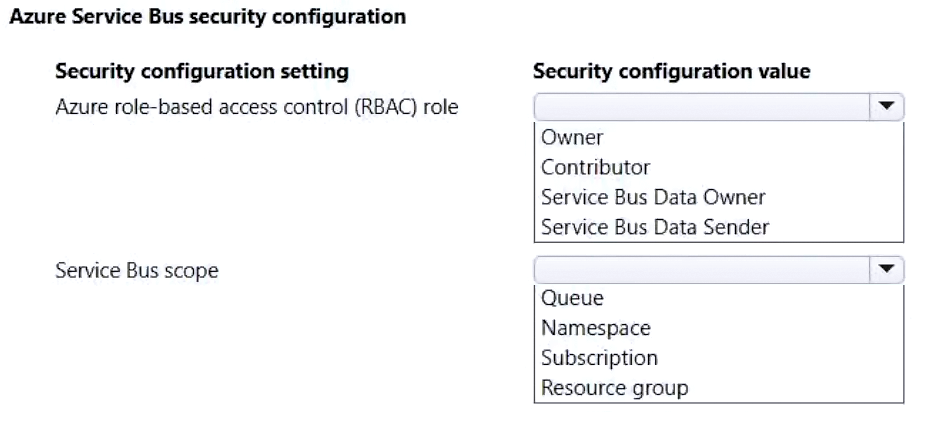
Question 48:
Note: This question is part of a series of questions that present the same scenario. Each question in the series contains a unique solution that might meet the stated goals. Some question sets might have more than one correct solution, while others might not have a correct solution.
After you answer a question in this section, you will NOT be able to return to it. As a result, these questions will not appear in the review screen.
You deploy an Azure Container Apps app and disable ingress on the container app.
Users report that they are unable to access the container app. You investigate and observe that the app has scaled to 0 instances.
You need to resolve the issue with the container app.
Solution: Enable ingress, create an HTTP scale rule, and apply the rule to the container app.
Does the solution meet the goal?
A.
Yes
B.
No
Question 49:
Note: This question is part of a series of questions that present the same scenario. Each question in the series contains a unique solution that might meet the stated goals. Some question sets might have more than one correct solution, while others might not have a correct solution.
After you answer a question in this section, you will NOT be able to return to it. As a result, these questions will not appear in the review screen.
You deploy an Azure Container Apps app and disable ingress on the container app.
Users report that they are unable to access the container app. You investigate and observe that the app has scaled to 0 instances.
You need to resolve the issue with the container app.
Solution: Enable ingress and configure the minimum replicas to 1 for the container app.
Does the solution meet the goal?
A.
Yes
B.
No
Question 50:
You are developing a microservice to run on Azure Container Apps for a company. External HTTP ingress traffic has been enabled.
The company requires that updates to the microservice must not cause downtime.
You need to deploy an update to the microservices.
What should you do?
A.
Enable single revision mode.
B.
Use multiple environments for each container.
C.
Use a private container registry and single image for all containers.
D.
Use a single environment for all containers.
E.
Enable multiple revision mode.
Disclaimer:
The content on this webpage is collected from various internet sources. While we strive for accuracy, we cannot guarantee its completeness or correctness. Please use it with caution and conduct further research if needed. We do not claim ownership or copyright over any content. If you find any copyrighted material or content that violates laws, please contact us for removal. By accessing this webpage, you agree to these terms. Thank you for your understanding.
The content on this webpage is collected from various internet sources. While we strive for accuracy, we cannot guarantee its completeness or correctness. Please use it with caution and conduct further research if needed. We do not claim ownership or copyright over any content. If you find any copyrighted material or content that violates laws, please contact us for removal. By accessing this webpage, you agree to these terms. Thank you for your understanding.